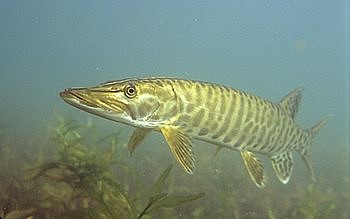DNR Study Shows Muskies Stay Close To Home
June 27, 2017 at 3:47 p.m.

DNR Study Shows Muskies Stay Close To Home
By Staff Report-
Biologists with the Department of Natural Resources say muskies, a large predatory fish, show some affinity to general areas at the 774-acre lake. Their assessment is based on recapture locations of tagged muskies caught each spring during egg-taking operations.
“We’ve been following the fate of hundreds of tagged muskies in Webster Lake for the past 12 years,” said Jed Pearson, DNR fisheries biologist. “Many of them are caught over and over again, so we’re learning a lot about where they go during spawning season.”
Now mind you, Pearson can’t say where you can catch a muskie, but he can tell you a little about their behavior. He gleaned the information from muskies tagged with PIT-tags, the same kind imbedded in cats and dogs for pet owners.
Biologists caught nine muskies this spring that were tagged years ago. They then looked up where they had caught those fish before. Seven were caught in the same general areas where they were caught previously.
“We caught a 34-inch female in 2011 in the Backwater, a large marsh at the south end of Webster,” Pearson said. “We caught her again 2014 and in 2015 – also in Backwater. By then she was 42 inches long.”
Biologists caught her again this year. Where? Backwater of course. This time the fish was 44 inches long, having grown 10 inches during the past six years.
Likewise, a 32-inch male muskie first caught in 2010 appeared to ramble more but still had a regular hangout.
“We caught this fish five times between 2010 and 2017,” Pearson said. “Twice we found it in Backwater and twice off the island in the main lake. In 2013 we caught him in the channel between the two.”
In contrast to the female, the male muskie grew only four inches longer over the seven-year period. Several studies have shown male muskies grow slower than females.
In 1998 and 1999, Pearson conducted a muskie tracking study at Webster using tiny radio-transmitters to follow their seasonal movements.
“We saw the same thing back then,” he said. “A big female spent much of the year in the main lake but went back to Backwater for spawning. I guess there is no place like home.”
Biologists with the Department of Natural Resources say muskies, a large predatory fish, show some affinity to general areas at the 774-acre lake. Their assessment is based on recapture locations of tagged muskies caught each spring during egg-taking operations.
“We’ve been following the fate of hundreds of tagged muskies in Webster Lake for the past 12 years,” said Jed Pearson, DNR fisheries biologist. “Many of them are caught over and over again, so we’re learning a lot about where they go during spawning season.”
Now mind you, Pearson can’t say where you can catch a muskie, but he can tell you a little about their behavior. He gleaned the information from muskies tagged with PIT-tags, the same kind imbedded in cats and dogs for pet owners.
Biologists caught nine muskies this spring that were tagged years ago. They then looked up where they had caught those fish before. Seven were caught in the same general areas where they were caught previously.
“We caught a 34-inch female in 2011 in the Backwater, a large marsh at the south end of Webster,” Pearson said. “We caught her again 2014 and in 2015 – also in Backwater. By then she was 42 inches long.”
Biologists caught her again this year. Where? Backwater of course. This time the fish was 44 inches long, having grown 10 inches during the past six years.
Likewise, a 32-inch male muskie first caught in 2010 appeared to ramble more but still had a regular hangout.
“We caught this fish five times between 2010 and 2017,” Pearson said. “Twice we found it in Backwater and twice off the island in the main lake. In 2013 we caught him in the channel between the two.”
In contrast to the female, the male muskie grew only four inches longer over the seven-year period. Several studies have shown male muskies grow slower than females.
In 1998 and 1999, Pearson conducted a muskie tracking study at Webster using tiny radio-transmitters to follow their seasonal movements.
“We saw the same thing back then,” he said. “A big female spent much of the year in the main lake but went back to Backwater for spawning. I guess there is no place like home.”
Have a news tip? Email [email protected] or Call/Text 360-922-3092



